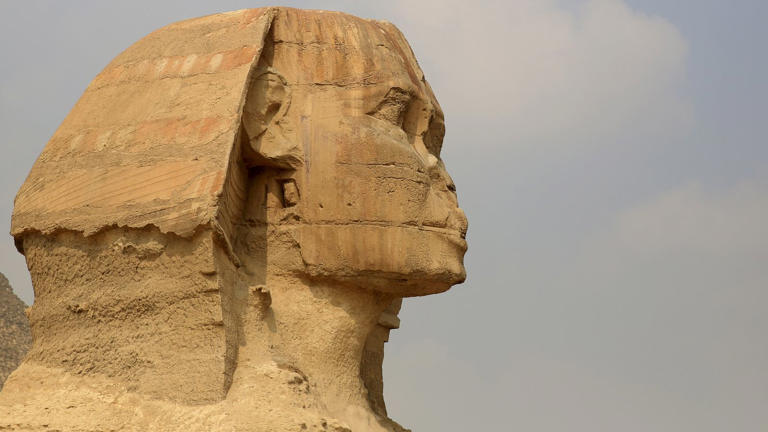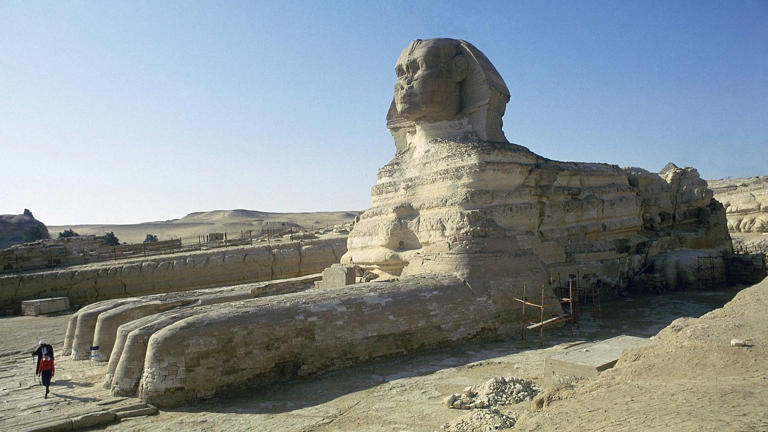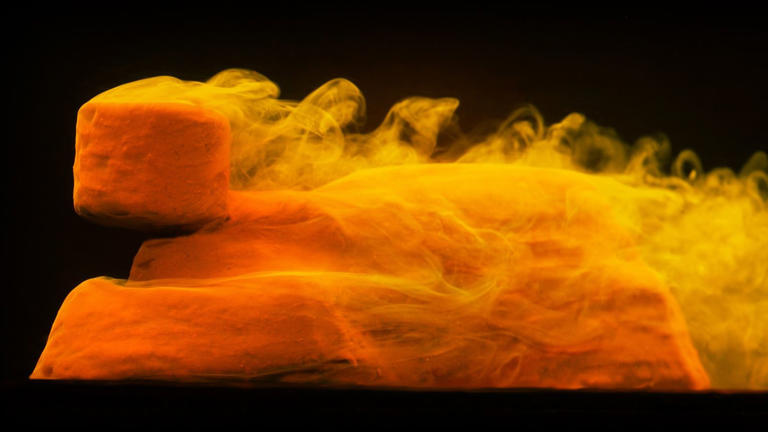SCIENTISTS DISCOVER 'ORIGIN STORY' OF GREAT SPHINX OF GIZA

















Scientists discover 'origin story' of Great Sphinx of Giza
With the face of a woman and the body of a lion, the Great Sphinx of Giza has enthralled and mystified archaeologists for thousands of years.
What did it originally look like? Who was it designed to represent? These are among the popular questions historians have wrestled with.
But there is another controversial mystery - did Mother Nature play a role in its creation? Did elemental forces erode the rock formation into something resembling the mythical creature before the Egyptians came along?
That's what a team of scientists from New York University have been trying to figure out.
"Our findings offer a possible 'origin story' for how Sphinx-like formations can come about from erosion," explains Leif Ristroph, an associate professor at NYU.
"Our laboratory experiments showed that surprisingly Sphinx-like shapes can, in fact, come from materials being eroded by fast flows."
The study centred on replicating unusual rock formations found in deserts from wind-blown dust and sand - known as yardangs.
Mr Ristroph's team explored the possibility that the Great Sphinx was originally one of these yardangs that was then subsequently detailed by humans.
To do this they took mounds of soft clay with harder, less erodible material embedded inside - mimicking the terrain in northeastern Egypt, where the Great Sphinx sits.
They then washed these formations with a fast-flowing stream of water to replicate wind that carved and reshaped them, eventually reaching a Sphinx-like formation.
The harder or more resistant material became the "head" of the lion and many other features such as an undercut "neck," "paws" laid out in front on the ground, and arched "back" developed.
"Our results provide a simple origin theory for how Sphinx-like formations can come about from erosion," observed Mr Ristroph.
"There are, in fact, yardangs in existence today that look like seated or lying animals, lending support to our conclusions."
Reference: Sky News:
Articles - Latest
- FRENCH PALME D’OR WINNER LAURENT CANTET DIES AGED 63
- Norman Lear obituary
- AN UNHOLY TRAFFIC: HOW THE SLAVE TRADE CONTINUED THROUGH THE US CIVIL WAR
- QUEEN CHARLOTTE WAS ‘PERSON OF COLOUR’, MUSEUM CLAIMS IN LGBT GUIDE
- JEANETTE WINTERSON: I DIDN’T BELIEVE IN GHOSTS… UNTIL I STARTED LIVING WITH THEM
- ANCIENT HUMAN ACTIVITY DISCOVERED IN KILOMETER-LONG LAVA CAVE
- DNA ANALYSIS SPANNING 9 GENERATIONS OF PEOPLE REVEALS MARRIAGE PRACTICES OF MYSTERIOUS WARRIOR CULTURE
- LOST CITIES HIDDEN FOR THOUSANDS OF YEARS DISCOVERED UNDER FOREST
- LETTER: ALAN ARKIN OBITUARY
- ARCHAEOLOGISTS CRACK MYSTERY OF ANCIENT MAYA AFTER 7,000-YEAR-OLD REMAINS FOUND
- NEW JERSEY REP. DONALD PAYNE JR. DEAD AT 65
- WORLD'S TALLEST WOMAN' MARIA FELICIANA DOS SANTOS, 7FT3, DIES AGED 77
- UNDERWORLD DISCOVERY CHALLENGES OUR UNDERSTANDING OF HUMAN EVOLUTION
- MUSLIM SOLDIER MEMORIAL FUND £1 MILLION TO IMPROVE RELATIONS AFTER ISLAMOPHOBIA ISSUES
- SCIENTISTS DISCOVER 1ST-OF-ITS-KIND CELL PART BORN FROM A SWALLOWED MICROBE
- NYC TIKTOK STAR EVA EVANS DIES AGED 29
- LADY GARDNER OF PARKES, CONSERVATIVE PEER WHO CHAMPIONED WOMEN’S RIGHTS IN THE EU AND UN – OBITUARY
- WEBB TELESCOPE DETECTS LIGHT FROM AN EARTH-LIKE PLANET
- FORMER LABOUR MINISTER AND CROSSBENCH PEER FRANK FIELD DIES AGED 81
- LOURDES PORTILLO DEAD AT 80:OSCAR-NOMINATED FILM DIRECTOR HAS PASSED AWAY
- VAMPIRE' NEUTRON STAR BLASTS ARE RELATED TO JETS TRAVELING AT NEAR-LIGHT SPEEDS
- THE MOON IS 40 MILLION YEARS OLDER — EXPLAINED
- BARBARA O.JONES DEAD AT 82: ACTRESS WHO STARRED ALONGSIDE MUHAMMAD ALI IN TV SERIES, HAS PASSED AWAY
Articles - Most Read
- Main
- Contact Us
- The science behind Ouija boards
- Cosmic Consciousness - What is Cosmic Consciousness-2
- Cosmic Consciousness-Introduction
- Cosmic Consciousness - Introduction-2
- MASSIVE 6.1 MAGNITUDE EARTHQUAKE HITS NEW ZEALAND AS NATION STILL REELING FROM CYCLONE
- ARCHAEOLOGISTS UNRAVEL THE TRUTH OF APHRODITE, GODDESS OF LOVE, ON VALENTINE'S DAY
- The Human Condition-Thomas Keating
- Cosmic Consciousness First Words - 1V - 2
- Cosmic Consciousness First Words - V -
- Cosmic Consciousness V - 2
- Cosmic consciousness - First Words - IV
- Cosmic Consciousness - What is Cosmic Consciousness?
- Evolution and Devolution-Chapter 2
- The Human Condition - Thomas keating-3
- The Human Condition-2-Thomas Keating
- Drinking From The Mountain Stream - Milarepa
- Cosmic Consciousness-On the Plane of Self Consciousness
- The Human Condition - 4
- Cosmic Consciousness - 3 - On the Plane of Self Consciousness
- Evolution and Devolution-Chapter 1
- The Human Condition - 6
- Shakyamuni Buddha or India the 1st “Black Revolutionary Hero.”
- On the Plane of Self Consciousness - 2
- Milarepa's World
- The Human Condition - 5
- Milarepa's World-2
- The Buddhist System of Liberation
- Contemplation and the Divine Therapy - 2
- On the Plane of Self Consciousness IV
- The Buddhist System of Liberation - 2
- JERRY RAWLINGS, GHANAIAN STRONG MAN WHO CAME TO POWER IN A COUP BUT INTRODUCED DEMOCRACY – OBITUARY
- On the Plane of Self Consciousness IV - 2





